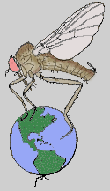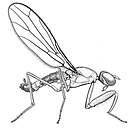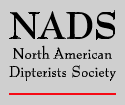
Diptera types in the Canadian National Collection of Insects
Home | Part 1 | Part 2 | Part 3 | Part 4 | Supplement

Supplement
Edition 4.0
Brooks, S.E., Sinclair, B.J., Cumming, J.M., O'Hara, J.E., Skevington, J.H., Lonsdale, O. & Cooper, B.E. 2015. Diptera types in the Canadian National Collection of Insects. Supplement. Edition 4.0. Electronic publication.
View the PDF file of Supplement
Introduction
This fourth edition of the Supplement updates the series of four catalogues on the Diptera types in
the Canadian National Collection of Insects (CNC). The first part (Cooper 1991), dealt with the
Nematocera and catalogued the types deposited in the collection until the end of 1987. The second
(Cooper & Cumming 1993), catalogued the primary types of brachyceran Diptera exclusive of the
Schizophora until the end of 1991. The third (Cooper & Cumming 2000), catalogued the primary types
of Schizophora exclusive of the Tachinidae in the collection until the end of 1994. The fourth part
(Cooper & O'Hara 1996), catalogued the primary types of Tachinidae deposited in the CNC until the
end of 1994. All four parts are also available as searchable PDF documents on the North America
Dipterists Society website (http://www.nadsdiptera.org/Catalogs/CNCtypes/CNChome.htm). This supplement
brings the total number of species of Diptera represented by name-bearing types in CNC to 5021
(including 4655 species represented by holotypes, lectotypes and neotypes and 366 species
represented by syntypes).
The Supplement covers the entire Diptera and includes all primary types published after the dates listed above for each part, as well as those types discovered since or inadvertently missed during the preparation of Parts 1 to 4, or needing some form of correction or update since the original entry. Of particular note, this fourth edition of the Supplement updates several entries from Cooper (1991) and Cooper & Cumming (2000) for species described by Garrett (1925b). In these entries, the type specimens were originally interpreted as syntypes; however, Garrett clearly refers to a "Type" for all but one of the included species (i.e., Pseudoleria crassata Garrett), and in the last line of the paper states "Accompanying these types are 385 paratypes." This statement, along with the explicit type labels Garrett attached to the specimens, clearly indicates his intention to recognize a single specimen as the holotype for the species described in that work.
The format for the Supplement is the same as in the previous parts, with entries listed using the original combination and spelling. Subgeneric names are included if they were used in the original description of a new species. Entries include the following information: name of taxon and author; year of publication; abbreviated reference, including volume, relevant page; and current name of country from which the primary type was collected. Unless otherwise noted, the label data associated with each primary type and allotype are cited in full, with diagonal lines separating information given on separate labels (a diagonal line not followed by a space indicates that the diagonal line is present on the label). The number of paratypes or paralectotypes is given along with their country or province/state of origin. The sex of each specimen is given. Notes about nomenclature, genitalic dissections, major damage to primary types, etc., are included wherever necessary under Remarks.
Unlike Parts 1 to 4, a hardcopy publication of the Supplement is not available. This fourth edition of the Supplement supersedes the first, second and third editions, which were published exclusively on the Internet in January 2000, December 2003 and January 2007, respectively. Users should first search the appropriate Part and then this Supplement to obtain information on the type holdings in the CNC for a particular family. However, users should be aware that the Supplement takes into account recent changes in the family classification of the Diptera (as outlined in Pape et al. 2011), such as the splitting of the traditional Tipuloidea, Sciaroidea and Empidoidea into several additional families. Therefore some generic entries previously listed as Tipulidae may now be found under Limoniidae, some generic entries previously listed as Mycetophilidae may now be found under Keroplatidae, and some generic entries previously listed as Empididae may now be found under Atelestidae, Brachystomatidae or Hybotidae. Additional recent family changes include the splitting of Mythicomyiidae from Bombyliidae, the lumping of Nycteribiidae and Streblidae under Hippoboscidae, and the Tethinidae under Canacidae, and recognition of the Paraleucopidae (see Wheeler 2010), although nomenclatural validation of this family is still in doubt.
Corrections, additions and comments should be forwarded to Scott Brooks (Scott.Brooks@agr.gc.ca), for inclusion in future editions of the Supplement.
Edition 4.0 published on the Internet on 24 February 2015
J.E. O'Hara



